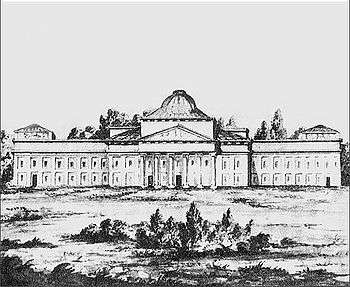Ignacy Jakub Massalski
| His Excellency Ignacy Massalski | |
|---|---|
| Prince Bishop of Vilnius | |
|
| |
| Coat of arms |
Masalski  |
| Family | Massalski |
| Father | Michał Józef Massalski |
| Mother | Franciszka Ogińska |
| Born |
30 July 1726 Olekszczyce near Grodno |
| Died |
28 June 1794 (aged 67) Warsaw |
Prince Ignacy Massalski (Lithuanian: Ignotas Jokūbas Masalskis) (1726–1794) was a Polish-Lithuanian nobleman.
Ignacy became a Catholic priest and was named Bishop of Vilnius by Pope Clement XIII on 29 March 1762.[1] He was one of the initiators of the Commission for National Education. During his time on the Commission, Massalski set up 300 parish schools.[2]
In 1776 he was removed from the Commission[3] for embezzlement of public funds[4] He was succeeded as head of the Commission by Michał Jerzy Poniatowski.[3]

He was a supporter of the Targowica Confederation and an opponent of the Kościuszko Uprising. As bishop, Massalski was opposed to the kidnapping and forcible conversion of Jewish children. He published a pastoral letter in 1783 condemning such practices.[5]
Massalski commissioned the reconstruction of the Vilnius Cathedral by Laurynas Gucevičius, which brought it to its present appearance.[6] He became the owner of the Verkiai Palace in 1780 and organized its major reconstruction in the Neoclassical style, also by Gucevičius.
Accused of treason, he was hanged in Warsaw on 28 June 1794 by an angry mob in the aftermath of the Warsaw Uprising.
References
- ↑ Hierarchia Catholica medii et recentioris aevi, v. VI, Patavii 1958, p. 442 (Latin)
- ↑ Daniel Stone (2001). The Polish-Lithuanian State, 1386-1795. University of Washington Press. p. 314. ISBN 978-0-295-98093-5. Retrieved 22 July 2012.
- 1 2 Jerzy Lukowski (5 August 2010). Disorderly Liberty: The Political Culture of the Polish-Lithuanian Commonwealth in the Eighteenth Century. Continuum International Publishing Group. p. 168. ISBN 978-1-4411-4812-4. Retrieved 22 July 2012.
- ↑ Norman Davies (30 March 2005). God's Playground: The origins to 1795. Columbia University Press. p. 397. ISBN 978-0-231-12817-9. Retrieved 22 July 2012.
- ↑ Gershon David Hundert (1 August 2006). Jews in Poland-Lithuania in the Eighteenth Century: A Genealogy of Modernity. University of California Press. p. 67. ISBN 978-0-520-24994-3. Retrieved 22 July 2012.
- ↑ Saulius Sužiedėlis (7 February 2011). Historical Dictionary of Lithuania. Scarecrow Press. p. 185. ISBN 978-0-8108-4914-3. Retrieved 22 July 2012.